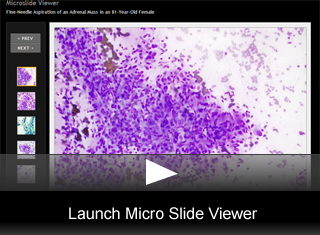Fine Needle Aspiration of 81 Year-Old Female with an Adrenal Mass
by Brent J. Huddleston, MD Fellow, Cytopathology. University of Utah, Department of Pathology
Editor: Brian T. Collins, MD, Professor of Pathology, University of Utah, and Medical Director, Cytopathology, ARUP Laboratories
An 81-year-old female residing in a skilled nursing facility has a past medical history significant for hypertension, diabetes mellitus, hypothyroidism, hyperlipidemia, and coronary artery disease. The patient complains of an approximately 5-month history of weakness, fatigue, decreased oral intake, 20-pound weight loss, night sweats, nausea, vomiting, and occasional syncope. These have all been getting worse over time. The syncope occurs while standing or sitting and she has had approximately 3 to 4 episodes of complete blackout. She also complains of occasional chest pain with lightheadedness and palpitations. Her orthopedic surgeon saw her for back pain and felt a lump in her axilla and neck, and ordered an MRI of her abdomen that revealed a right adrenal mass. CT-guided fine needle aspiration was performed of the adrenal mass.
FNA Findings
Fine needle aspiration shows the following:
- The smears are cellular with mostly cohesive groups of cells (fig. 1).
- Some discohesive and loose acinar patterns are seen (fig. 2).
- There is a prominent vascular network of capillaries within the larger cell groups (fig. 3).
- The nuclei are mostly round to oval (fig. 4) with some scattered pseudonuclear inclusions (fig. 5).
- There is moderate anisonucleosis with some binucleate forms present. Nucleoli are prominent (fig. 3).
- The cytoplasm is abundant, granular, with indistinct cell borders, and appears fragile with many stripped nuclei present (fig. 5).
- The cells appear to be connected by anastomosing strands of cytoplasm, best seen on the Papanicolaou stained smears (fig. 6).
- The cell block shows that the cells are arranged in a nested pattern separated by a rich vascular network (fig. 7).
- Immunohistochemical stains are performed (fig. 8).
Final Diagnosis & Discussion
© The copyright for photographs and digital images shown in this case report is owned jointly by Brian Collins, MD and ARUP Laboratories, Inc. Unlicensed publication in print, on the internet, or in any other media form of these digital images or photomicrographs for any purpose without written permission is strictly prohibited. Limited use for teaching is permitted. Please contact The Webmaster for licenses and permissions. If you wish to use these images as aid in lectures or scientific slide presentations, each image should accompany the following text: "copyrighted material: www.arup.utah.edu"
 Site Search
Site Search


